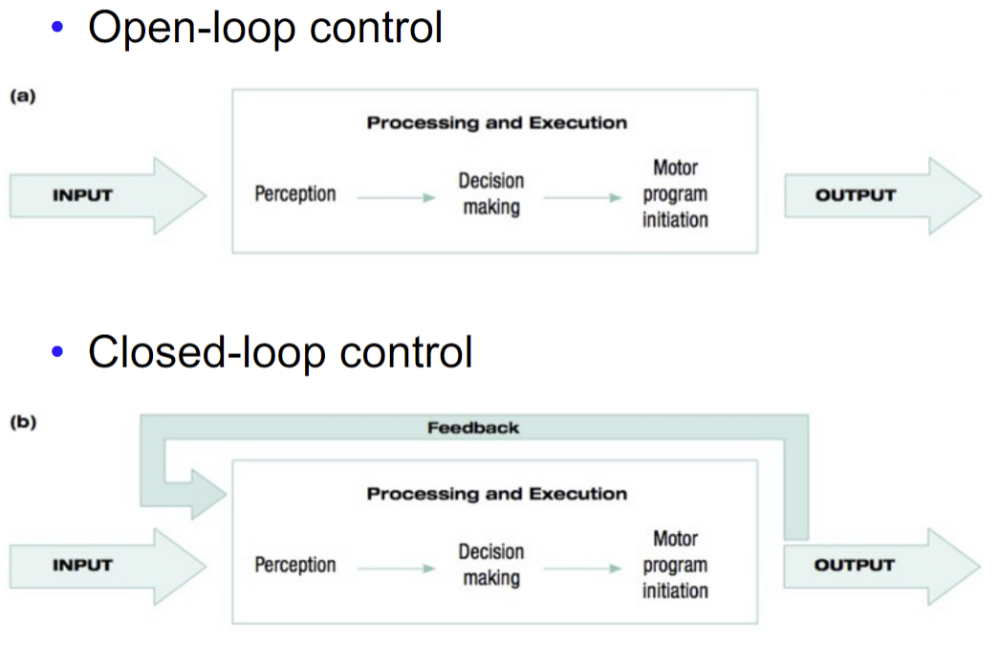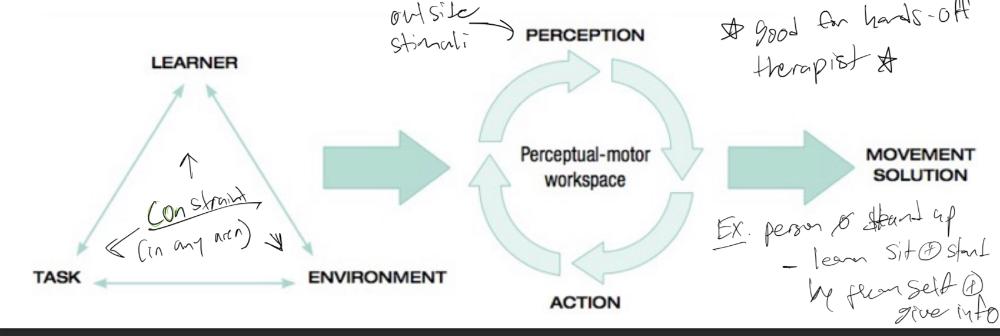Coordination and Control
- degrees of freedom
- coordination
- control
Coordination and Control
Degrees of Freedom
- independent elements of each limb
- body => joints (all action possibilities)
Coordination and Control
Coordination
-
organizing a system's degrees of freedom
- into an efficient movement pattern
- to achieve a desired result
- to provide a skilled mvt
- "Putting ingredients into a soup"
Coordination and Control
Control
-
manipulation of variables within a movement to meet
the demands of a given situation
- motor skill into different environments // changing varibles
- given situation = taken account of degree of freedom
Motor Program Theories
- theory based upon the brain as the "command center" for movement
Generalized motor program
- class of actions or pattern of movement that can be modified to yield a response outcome
Invariant features
- Relatively FIXED // NO CHANGE
- EX. same letter
- Fixed in motor skill
- Defines motor program (WHAT)
Parameters
- FLEXIBLE // YES CHANGE
- different tasks or changes
- defines EXECUTION of program (HOW+PLAYED OUT)
Invariant Features
- sequence of actions
- relative timing
- relative force
Invariant Features
sequence of actions
- order of components = doesn't really change
- EX: volleyball spike = fixed
Invariant Features
Relative timing
- internal RHYTHM of the skill
- EX: Swim fast vs. swim
slow
- = same swim technique
- EX: Swim fast vs. swim
slow
- Regardless of speed = component mvt does NOT change
- Cyclical events: hurdling, swimming, ect.
Invariant Features
Relative Force
- tension created in muscles
- proportionate regardless of resistance
- EX: Air squats vs. 50lb squat
- muscle use = STILL SAME
Parameters
- overall duration
- overall force
- movement direction
- muscle selection
Parameters
Overall duration
- duration or speed of the skill is performed // MVT does not
change
- Long vs. short
- Fast vs. Slow
Parameters
Overall force
- amplitude of the movement
- strength / power / range
- EX. long vs. short pass
- EX.
learn to sit => stand
- can do same # from high to low surface
Parameters
Movement direction
- directional passes, shots, ect.
- mvt needing aim (darts, pulling items to grab)
Parameters
Muscle selection
- use different muscels to accomplish the same task
- EX. different hands
- EX. writing w/ hands VS. writing w/ mouth
Schema (WIP)
- a rule or relationship that directs
decision during a movement pattern
- develops as a result of accumulated experiences (INFO) within a class of action
- Already learn to change
- Each attempt = builds bigger schema
Schema
Sources of Information
-
initial conditions
- start info @ start of mvt
-
response specifications
- parameters used for execution (amt of speed/force)
-
sensory consequences
- feedback fr. mvt (what felt during/after mvt)
-
response outcome
- success/fail of mvt
Schema
Recall schema
- organizes the motor program that initiates and controls desired movement
- subconsciously selected based on actual outcomes and response specifications
Schema
Recognition schema (fr. outside info)
- based upon relationship between inital conditions, past outcomes, sensory consequences
- comparison btn sensory feedback + reference of correctness
Motor program execution

-
Open-loop control
- brain general action plans w/o modification
- feedback present BUT too late
- EX. after a softball toss when pitching
-
Close-loop control
- for beginners to learn
- allows adjustments to be made after attempt
- EX. Golf putting
Evidence for motor program control
-
reaction time increases = task complexity increases
- mvt planned in advance
-
deafferentation
- MONKEY
- severing of nerves responsible for CNS sensory feedback
-
electromyography studies
- similar activation in muscles for BLOCKED and UNBLOCKED limbs
Dynamic Interaction TheoryDynamic Interaction Theory
- movements occur in response to
- dynamic interaction of person
- environment
- task
- movement patterns = result of constraints
- IMPOSED by given situation
- EX. finger movements with metronome // traffic (unexpected // can't explain movements)
Dynamic Interaction Theory
Constraints
- individual
- environment
- task
Dynamic Interaction Theory // Constraints
Individual
- body attributes // personality characteristics // fitness varibles
- EX: playing volleyball on knees
Dynamic Interaction TheoryDynamic Interaction Theory // Constraints
Environment
- gravity // temperature // lighting // presence of spectators
Dynamic Interaction Theory // Constraints
Task (x3)
- Goal: outcome of action
-
Rules: physical boundaries, movements, etc.
- EX: fast pitch softball => don't lift toe off pitch
-
Implements: size of ball/goal, length of object,
etc.
- EX. athlete + smt else //
changes in movement
- control parameter
- rate limiters
- phase shifts
changes in movement
Control parameter
- variables that, when changed, lead to changes in the collective behavior of the system
- direction, force, speed, perceptual information
changes in movement
Rate-limiters
- constraints that INHIBIT a system to change
- DOES NOT CHANGE // when sm1 injuried
- Strength, size,
speed, etc.
- EX. hop flexor gait walking example
changes in movement
Phase shifts
- changes in movement behavior are the result of
- series of transitions in a system's state of stability
- EX. log walk // increase or decrease balance // swinging a heavy vs. light bat
- Implement 3 weeks before big game
- series of transitions in a system's state of stability

Non-linear pedagogy
- learners search through a range of potential movement
solutions
- for an optimal strategy
Perceptual-Motor Workplace
- represents practice content for the learner
- perception <=> action